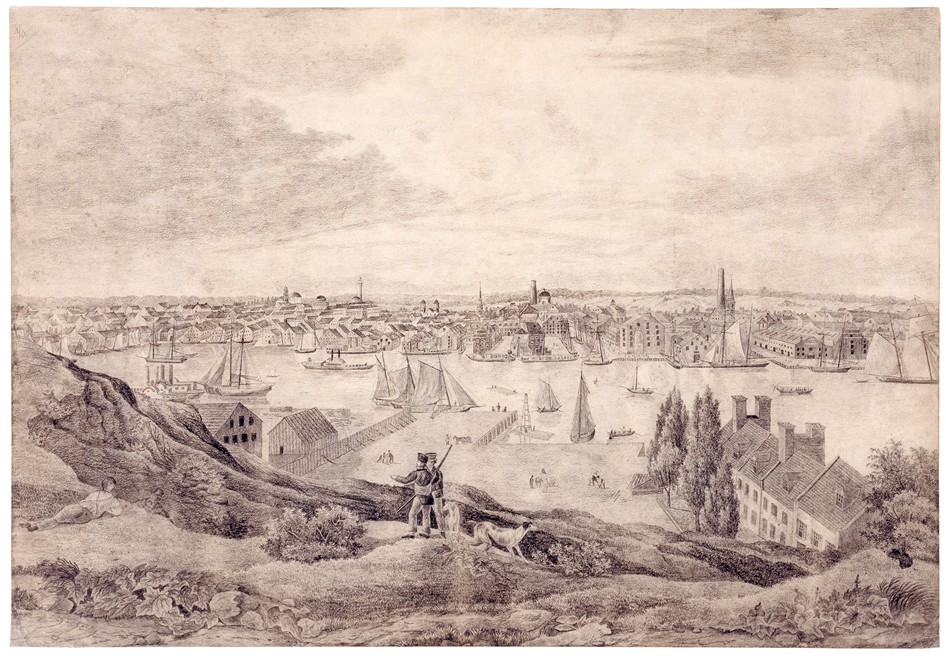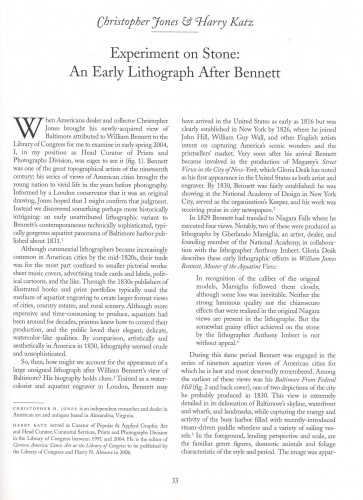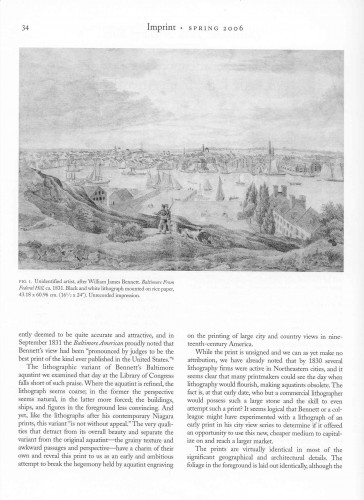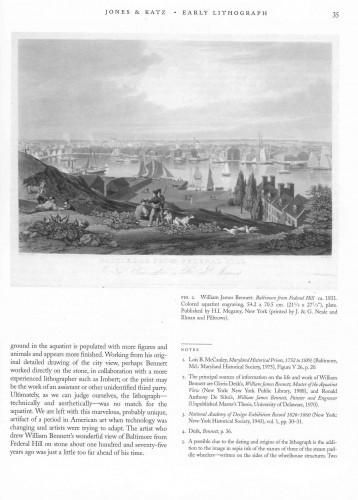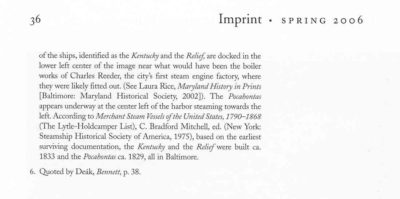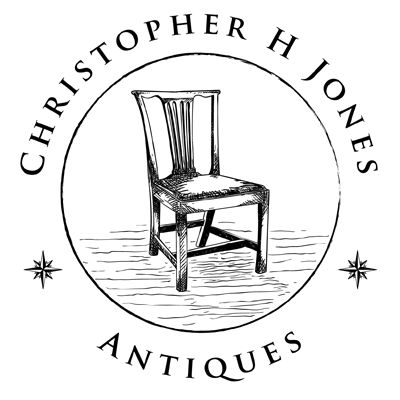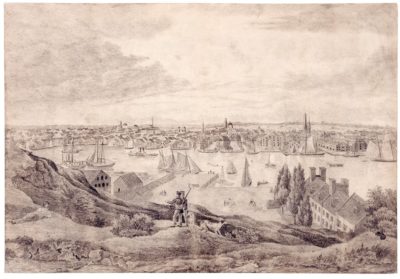 Black and White lithograph after William James Bennett
Black and White lithograph after William James Bennett
Dimensions: 16 ” x 24″
Maker: unrecorded example attributed to William James Bennett (1787 – 1844)
Date: Ca.1831
Commentary: This important print represents one of the earliest attempts to present an American city view by means of lithography. It is a milestone in the history of printing technology in America, the development of the large scale printed urban view, and the depiction of Baltimore in the early 19th century United States. While it is unquestionably closely related to the well known aquatint view by William James Bennett, the nature of the relationship between these prints, other early lithographs, and the identity of the lithographer, remain unclear and the subject for further scholarship. As the recent Imprint article, co-authored with Harry Katz, suggests, the print was probably executed directly from Bennett’s original drawing or watercolor but did not achieve the desired sense depth, perspective or nuance. The experiment was abandoned in favor of the aquatint version that was among the first of Bennett’s famous series of city views and would not be taken up again by other artist and printers for several more years. This “proof” is important evidence of an early effort to apply a new technology to an evolving art form and a rapidly expanding marketplace. Only in the next decade did the art and science of lithography reach a point that it could supplant engraving as the preferred process for commercial production of large city views.
Trained as a watercolorists and aquatint engraver in London, Bennett may have arrived in the United States as early as 1816 but was clearly established in New York by 1826 where he joined John Hill, William Guy Wall and other English artists intent on capturing America’s scenic views in print. Quickly after his arrival Bennett was deeply involved in the production of Megarey’s Street Views in the City of New-York, which Gloria Deak notes as his first appearance as both artist and engraver. (Gloria Gilda Deak, William James Bennett, Master of the Aquatint View, New York, 1988) By 1830 Bennett was showing at the National Academy of Design, had been retained by that organization as its Keeper or curator, and his work was receiving positive notice in the New York’s newspapers. In 1829 Bennett traveled to Niagara Falls where he painted at least four views. Two were produced as aquatints by John Hill and two were produced in aquatint by Bennett. Most notably, two of the views were produced as lithographs by Gherlando Marsiglia, an artist, dealer and founding member of the National Academy, in collaboration with the lithographer Anthony Imbert Gloria Deak describes these early lithographic efforts: “In recognition of the caliber of the original models, Marsiglia followed them closely, although some loss was inevitable. Neither the strong luminous quality not the chiaroscuro effects that were realized in the original Niagara views are present in the lithographs. But the somewhat grainy effect achieved on the stone by the lithographer Anthony Imbert is not without appeal.”
During this same period Bennett was deeply engaged in the series of nineteen views of American cities, done in aquatint, for which he is best and most deservedly remembered. Among the earliest of these views was his View of Baltimore From Federal Hill, one of two depictions of the city he probably produced in 1830. This view is extremely detailed in its delineation of Baltimore’s skyline, waterfront and wharfs, and landmarks, while capturing the energy and activity of the busy harbor filled with both recently introduced steam driven paddle wheelers and a variety of sailing vessels. In the foreground, lending perspective, are the familiar genre figures, domestic animals and foliage characteristic of the style and period. In September 1831 the Baltimore American proudly noted that Bennett’s view had been “pronounced by judges to be the best print of the kind ever published in the United States.” The lithographic view is virtually identical to the aquatint in its content and composition with the exception of the fanciful genre figures in the foreground. It lacks, however, the sense of perspective, depth and mass achieved by the aquatint, shortcomings indicative of the artist’s lack of familiarity with the process.
It seems likely that Bennett was, as had been the case with the lithographed views of Niagara Falls, experimenting with a mass production printing process that was less expensive and more commercially competitive than aquatint engraving. By the 1830s artists and publishers had sensed the rapidly growing demand for decorative prints but only a few city views had been published as book illustrations and only a very few other issued as separate sheets. Bennett must have been intrigued by the possibilities of lithography but disappointed by the results when compared to the aquatint with he had long training and familiarity, and abandoned the project. Barely a decade later publishers such as Sachse and Bachmann had mastered the nuances of the lithographic process, but neither Bennett or his peers could have foreseen that by the end of the century some five thousand prints of American towns and cities would have been produced representing some twenty four hundred separate places making this art form among the most popular in America.
An intriguing aspect of this print is the addition of the names of three of the steam paddle wheel ships pictured in the harbor in precisely lettered old sepia ink on the side wheelhouse structures. The two primary references on the history of steam vessels working out of Baltimore (Merchant Steam Vessels of the United States, 1790 – 1868 and Chesapeake Steamboats) rely upon the earliest known documentation referring to a ship to date its commissioning and are often necessarily imprecise in light of lost construction documents and other records. Two of the ships named in the print, the Kentucky and the Relief , first appear in Baltimore maritime records in 1833 . They are docked in the lower left center near what would have been the boiler works of Charles Reeder, the city’s first steam engine factory, where they were likely fitted out. These two ships may have been under construction when depicted. The Pocahontas, listed as having been built Baltimore in 1828-1829, appears underway at the center left of the harbor steaming towards the left.
According to McCauley’s Maryland Historical Prints, in the years after its publication, several attempts were made at pirating Bennett’s view of Baltimore’s harbor. Edward Weber published two similar views around 1836 and the artist A. L. Garmeray published a version c. 1834. Comparisons indicate no relationship between these efforts and this lithographic view which is unrecorded and quite likely unique.
Condition and Materials: The print is in good condition and has been professionally cleaned, de-acidified and reinforced with rice paper.

